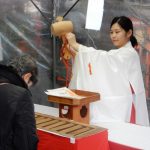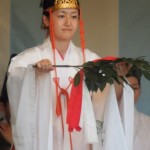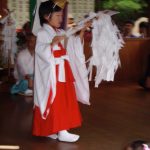
How did you get the job?
It was through my senior in my college club. She recommended me personally as I was looking for a job. I had good manners so that’s why I was chosen.
How long did you do the job?
I worked for two years at the Shiramine Shrine in Kyoto. It’s famous for kemari (traditional kick-ball). When I graduated, I gave up being a miko as I got a full-time job.
What training did you get?
Very little that I remember. Just about bowing at the right places and keeping good behaviour. No fooling about, that sort of thing.

How about the clothing?
We could borrow red hakama and white kimono from the shrine. Because you have to tie the belt very tightly around the middle, it felt a bit restricted and uncomfortable. I remember sweating a lot in summer.
How often did you work?
Actually I wasn’t there every day, but just called for special occasions such as festivals, weddings, New Year and Setsubun etc.
What did you have to do?
Selling things in the shrine shop mostly. Cleaning up and sweeping too.

How long was your working day?
We worked from 10.00 in the morning to 4.00 or 5.00 in the afternoon. We could get a free meal for lunch. I think we got something like ¥5000 to ¥7000 a day.
How would you describe the experience, looking back?
It was good. There were three priests and two miko, and we could enjoy working together. At festivals it was very busy, but we did not have to work too hard.
Is there anything you regret?
Yes, I wish I had studied more about shrine life while I was there. At the time I was just a student and not interested in history and things like that. Still I’m not religious, but now I feel I should know more than I do.


Thank you, John. This was lovely. I remember wandering into Shiramine Shrine in my ignorance and watching with fascination the kemari practice. Like this miko, I too wish I knew more.
A lucky chance if you came across them practising. The only kemari events I have attended were so crowded you couldn’t see the ball!